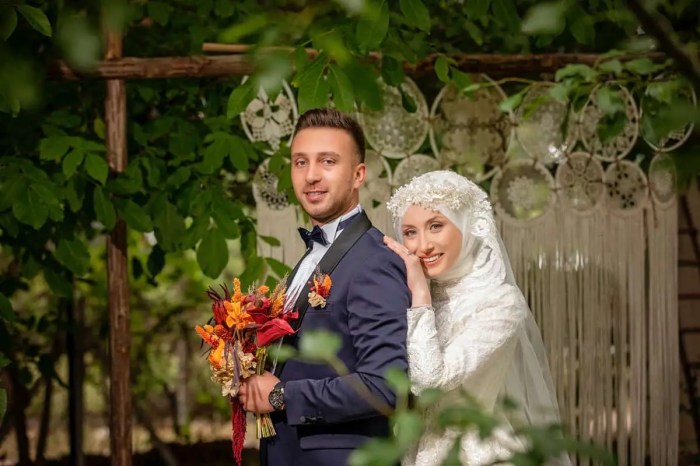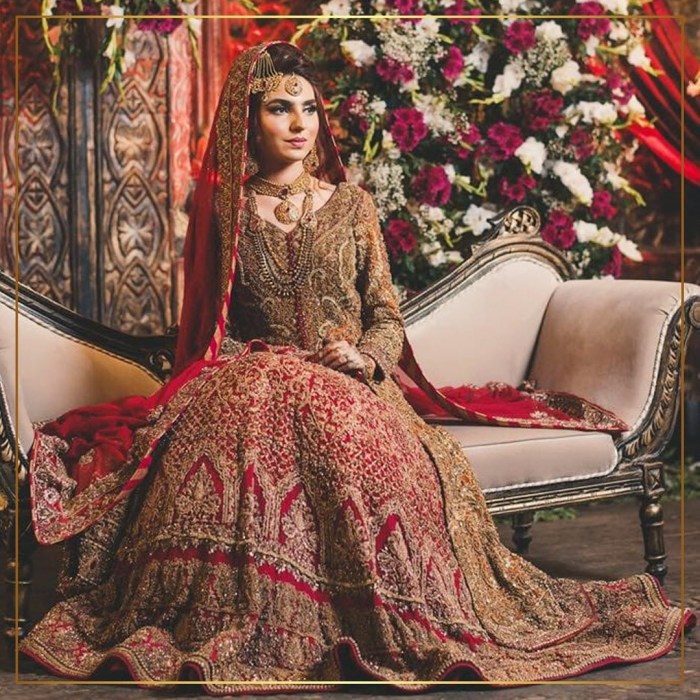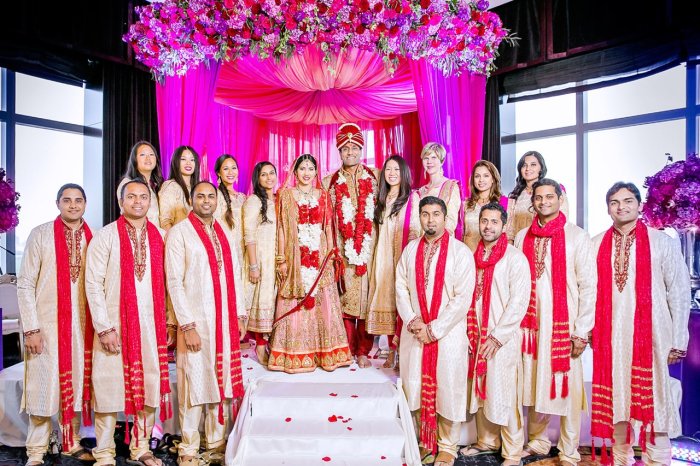Indian Muslim Wedding Dress A Celebration of Style
Regional Variations in Indian Muslim Wedding Dresses

Source: magicaldayweddings.com
Indian muslim wedding dress – Indian Muslim wedding attire showcases a rich tapestry of regional diversity, reflecting the country’s varied cultural heritage. Styles, fabrics, and embellishments differ significantly across various regions, creating a unique visual landscape for each celebration.
Regional Dress Styles
| Region | Typical Dress Style | Fabrics Used | Common Embellishments |
|---|---|---|---|
| North India | Sharara, Anarkali suits, Lehengas | Silk (Banarasi, silk), Velvet, Brocade | Zari embroidery, Resham work, Stonework, Kundan |
| South India | Lehengas, Sarees (Kanjeevaram, Mysore silk) | Silk (Kanjeevaram, Mysore), Cotton | Temple jewellery, Zardozi, Kasuti embroidery |
| East India | Sarees (Baluchari, Tant), Salwar Kameez | Silk (Baluchari, Muga), Cotton, Muslin | Traditional Bengali embroidery, zari work, minimal embellishments |
| West India | Lehengas, Ghagras, Cholis | Silk, Brocade, Velvet | Aari work, mirror work, Patchwork |
Bridal wear from North India often features opulent lehengas with elaborate embroidery and heavy embellishments, contrasting with the more understated elegance of South Indian sarees, which may incorporate traditional temple jewelry. Eastern styles lean towards simpler silhouettes with delicate embroidery, while Western styles often blend traditional elements with modern design sensibilities.
Historical Influences on Dress Styles, Indian muslim wedding dress
The current styles in North and South India reflect centuries of cultural exchange and historical influences. North Indian styles, particularly those incorporating Mughal influences, showcase rich fabrics and intricate embroidery reflecting the grandeur of the Mughal era. South Indian styles, on the other hand, draw inspiration from traditional temple art and architecture, resulting in a more understated yet sophisticated aesthetic.
Fabrics and Embellishments
The choice of fabrics and embellishments plays a crucial role in defining the overall look and feel of an Indian Muslim wedding dress. The selection often reflects the bride’s personal style, family tradition, and the region’s cultural heritage.
Common Fabrics and Embellishments
Common fabrics include silk (Banarasi, Kanjeevaram, Mysore), velvet, brocade, chiffon, and net. These fabrics are chosen for their luxurious texture, drape, and suitability for intricate embellishments. Embellishments such as zari work, embroidery (resham, zardozi, aari), stonework (kundan, precious stones), sequins, and mirror work add richness and detail. Zari, for instance, signifies wealth and prosperity, while intricate embroidery often tells a story or conveys a symbolic meaning.
Example Wedding Dress Design

Source: wedmeplz.com
Imagine a lehenga crafted from a base of rich Banarasi silk in a deep emerald green. Over this, a layer of sheer net embroidered with delicate silver zari creates a subtle shimmer. The choli is adorned with intricate aari work in gold thread, depicting floral motifs. Finally, scattered kundan stones add a touch of sparkle and sophistication.
The Role of Color and Symbolism
Color holds significant cultural meaning in Indian Muslim weddings. The choice of color often reflects the bride’s personality, family traditions, and aspirations for her future.
Color Significance and Regional Variations
Red traditionally symbolizes prosperity and good fortune, while green represents fertility and growth. Other popular colors include shades of gold, signifying wealth and royalty, and ivory, representing purity and grace. Regional variations exist; for example, brides in some regions might favor brighter, bolder colors, while others prefer more muted tones.
A Bride’s Color Choice

Source: insideweddings.com
Aisha, a bride from a family with a rich history in the weaving industry of Varanasi, chose a deep crimson lehenga. The vibrant red symbolized not only prosperity but also a tribute to her family’s heritage. The intricate gold zari work on the lehenga mirrored the intricate patterns of the Banarasi silks her ancestors had woven for generations. The color also represented her hopes for a bright and prosperous future with her beloved.
Modern Interpretations and Trends
Modern Indian Muslim wedding dresses often blend traditional elements with contemporary design sensibilities, creating a unique fusion of old and new.
Modern Design Elements
- Asymmetrical cuts
- Modern silhouettes
- Unique color palettes
- Fusion of traditional and western styles
- Minimalist embellishments
Accessories and Jewelry
Jewelry and accessories play a vital role in completing the bridal look. The selection process often involves careful consideration of the dress style, color, and the bride’s personal preference.
Jewelry Selection and Enhancement
Traditional jewelry includes necklaces (kundan, jhumkas), earrings (jhumkas, studs), bangles (gold, silver, embellished), and maang tikas. The selection of jewelry complements the dress and enhances the overall look. For instance, a heavy gold necklace might pair well with a simple, elegant saree, while lighter jewelry might be chosen for a heavily embellished lehenga. A delicate maang tika adds a touch of elegance and completes the traditional look.
The Bridal Veil (Dupatta): Indian Muslim Wedding Dress
The dupatta, or bridal veil, is an essential part of the wedding attire. Its style and draping method vary across regions and communities, adding a unique touch to the overall bridal look.
Dupatta Styles and Draping
Dupattas can be made from various fabrics, ranging from sheer chiffons to luxurious silks, and can be embellished with embroidery, zari, or other decorative elements. The dupatta can be draped in numerous ways: a simple drape over the shoulders, a more elaborate drape over the head and shoulders, or even incorporated into the overall design of the lehenga or saree.
Each style conveys a different aesthetic, reflecting regional preferences and individual choices.
Top FAQs
What is the average cost of an Indian Muslim wedding dress?
The cost varies greatly depending on the fabrics, embellishments, and designer. Prices can range from a few hundred to several thousand dollars.
How long does it typically take to have a wedding dress custom-made?
Indian Muslim wedding dresses often showcase intricate embroidery and rich fabrics. The celebratory atmosphere often inspires guests to choose similarly vibrant outfits, and a beautiful option for plus-size guests might be a floral plus size wedding guest dress , which complements the joyous occasion. Returning to the bride’s attire, the selection often reflects family traditions and personal style, resulting in a truly unique ensemble.
Custom-made dresses often require several months, sometimes longer, depending on the designer’s workload and the intricacy of the design.
Are there specific religious requirements for the dress?
While there aren’t strict religious rules dictating the dress style, modesty is generally preferred. The dress should typically cover the arms and legs.
Where can I find Indian Muslim wedding dress designers?
You can find designers through online searches, bridal magazines, and wedding boutiques specializing in South Asian attire. Local community networks can also be a valuable resource.
















